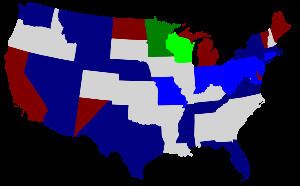November 6, 1934 1936 → 59 seats 36 seats 69 25 | Arkansas Oregon 60 35 9 10 | |
 | ||
Winner Joseph Taylor Ro | ||
The United States Senate elections of 1934 occurred in the middle of Democratic President Franklin Delano Roosevelt's first term. In the middle of the Great Depression, voters strongly backed Roosevelt's New Deal and his allies in the Senate. The Democrats picked up a net of nine seats, giving them a supermajority (which required 64 seats, two-thirds of the total 96 seats in 1934). This marked the first time since the Civil War where an incumbent president's party gained Senate seats during a midterm election, later being followed by John F. Kennedy in 1962, Richard Nixon in 1970, and George W. Bush in 2002.
Contents
Gains and losses
The Democrats took nine Republican seats, including an open seat in Maryland and the seats of eight incumbents.
Losing incumbents
- Connecticut: Frederic C. Walcott (R) lost to Francis T. Maloney (D)
- Indiana: Arthur Raymond Robinson (R) lost to Sherman Minton (D)
- Missouri: Roscoe C. Patterson (R) lost to Harry S. Truman (D)
- New Jersey: Hamilton F. Kean (R) lost to A. Harry Moore (D)
- Ohio: Simeon D. Fess (R) lost to Vic Donahey (D)
- Pennsylvania: David A. Reed (R) lost to Joseph F. Guffey (D)
- Rhode Island: Felix Hebert (R) lost to Peter G. Gerry (D)
- West Virginia: Henry D. Hatfield (R) lost to Rush D. Holt (D)
Retirement
- Maryland: George L. P. Radcliffe (D) picked up the seat when Phillips Lee Goldsborough (R) retired.
Party change
- Republicans suffered an additional loss when Robert M. La Follette, Jr. (WI) left the Republican Party to join the Progressive Party.
Complete list of races
Bold state indicates election article link. Bold candidate indicates winner.
November elections
All races are for the Class 1 seat, unless otherwise noted.
Bold states link to articles about the individual elections.
